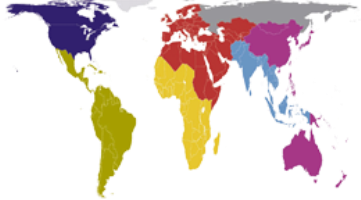Middle East and North Africa COVID-19 Update
United Church of Christ – Wider Church Ministries
Humanitarian Development Team
Coronavirus (COVID-19) Daily Briefing
Barbara T. Baylor, MPH – Temporary Health Liaison
 Middle East and North Africa COVID-19 Update
Middle East and North Africa COVID-19 Update
Jerusalem Post reports that, as of May 30, there were 587,777 cases of COVID-19 recorded across the Middle East and approximately 15,519 deaths from Morocco to Iran. Turkey and Iran had the most coronavirus cases with 162,120 and 146,668, respectively. Currently, numbers of cases are climbing, especially in the Gulf, Iraq and Egypt as better testing methods have developed and as several countries ease or lift restrictions and lockdown measures.
According to another source, Medium.com, as of June 11, 2020, the Middle East and North Africa excluding Iran have reported 409,885 COVID-19 cases and 5,357 deaths since the first cases were reported February 25, 2020. Over that same period, Iran reported 180,156 cases and 8,584 deaths. And numbers are increasing day by day across the region.
The economic outlook for this region is poor. The United Nations Economic and Social Commission for Western Asia estimates that 1.7 million people in the Middle East and North Africa will lose their jobs in 2020. Eight million more people will fall into poverty; half of them will be children. Impoverished people in this region have limited access to clean drinking water, adequate nutrition and sanitation, shelter, health care and education, which increases the burden of COVID-19.
Here are snapshots compiled in early June:
- Israel has seen a rise in COVID-19 infections since easing its lockdown. Currently, most of Israel’s new infections are in recently reopened schools. There also have been a few increases in care homes and nurseries.
- Saudi Arabia reported the region’s biggest one-day increase, reporting 3,288 new cases on June 6, followed by Iran with 2,269.
- Egypt, Iraq, Kuwait, Oman and Qatar each reported more than 1,000 new cases on June 6.
- COVID-19 cases in Oman now total more than 13,000. Recent increases may have been due to people socializing during the Muslim month-long observance of Ramadan.
- Iraq reported 1,006 new COVID-19 cases last Friday – by far the highest number since the epidemic began. Speculation is non-compliance with preventive measures.
- Jordan has seemingly met the criteria for lowering the country’s official COVID-19 risk level to “moderate” – defined by having fewer than 10 locally generated new cases over a period of seven consecutive days. Jordan is in a re-opening phase.
- Syria has imposed a lockdown on the town of Ras al-Ma’ara following a COVID-19 outbreak there which has so far resulted in 16 people becoming infected. This is the largest cluster of related cases reported by the Syrian authorities since the pandemic began.
- Iran is facing a consistent increase in weekly new cases for the third consecutive week coinciding with the lifting of restrictions. This country accounts to 41.5 per cent of recent deaths in the region.
- In Sudan, Syria and Yemen, risks of malnutrition and food insecurity are being further exacerbated by the pandemic.
- Egypt confirmed on Thursday (June 11) 1,442 COVID-19 cases, raising the total infections registered in the country since mid-February to 39,726.
- 230 COVID-19-related deaths were reported in the region yesterday – 75 of them in Iran. Egypt, Iraq and Saudi Arabia each reported more than 30 deaths.
The following is a brief report about the impact of the coronavirus on the Middle East as reported on the Global Ministries website. It reveals the everyday circumstances of people while unmasking the forces that make them more vulnerable.
With a large refugee and displaced population, the Middle East faces rapid spreading of COVID-19 among people with no place to isolate and with no reasonable access to healthcare.
In Syria, more than half of the population is either displaced within the country or seeking refuge in neighboring countries or beyond due to Syria’s 9-year war. Homes, towns and cities are destroyed, so Syrians often do not have permanent accommodations. When they do, either with family or with other refugees in camps (formal or makeshift), population densities are unusually high, preventing their ability to practice physical distancing or isolation, which increases each person’s susceptibility to contracting disease (COVID-19 and others).
Often living in less-than-ideal conditions, with no heat and inadequate nutrition, people’s immune systems are already compromised. They are unable to fight basic illness, let alone a pandemic. In addition, Syrians lack access to anything but basic healthcare.
For Palestinians living under Israeli occupation, the Coronavirus has compounded their isolation. Both the Israeli government and the Palestinian Authority have declared lockdowns, but these are two unequal powers with very unequal resources.
The health care system in the West Bank is not equipped to handle a pandemic of this magnitude, and access to Israeli health care facilities – or even Palestinian clinics and hospitals in Jerusalem – is severely reduced during lockdown conditions.
For 2 million Gazans, the Israeli blockade and containment is “normal” and is not being relaxed to allow the inflow of medicine and health needs or the outflow of sick people. More than a dozen cases of Coronavirus have been identified in Gaza, and it could spread very quickly and easily among the densely packed population.
Parallel to Israel’s blockade of Gaza, international (especially U.S.) sanctions against Iran have prevented the country, which is an epicenter of the virus, from accessing cash and medical needs to fight the spread of the virus. Iran’s population has experienced a high rate of COVID-19 with little ability to prepare for a health pandemic or treat massive numbers of needy patients.
Lebanon, Jordan, and Egypt are also in lockdown, doing what they can to counter the appearance of the virus. However, these countries are all dealing with economies that are already stretched thin, high levels of unemployment especially among the younger generations, and debt and dependence.
Partners in Italy and Greece still work to respond to continuing refugee presence and influx, despite high incidences of the virus in those countries and heavy restrictions limiting their abilities to offer comfort and relief.
As the virus continues to spread and cause more deaths, numbers and statistics are likely to obscure the names and faces of people who succumb to infection, as well as of those whose lives will forever be broken by the impact both of the disease and official and popular responses to it. Even if we hold that the pandemic does not discriminate and that all are vulnerable, we must acknowledge that some are more (likely) both to being infected as well as affected by policies to contain the virus.
Related News
Growing Weary
In December 1964 during a speech in Harlem, Fannie Lou Hamer declared: “And you can always...
Read MorePlanning for Earth Month: Resources for Congregations
April is Earth Month, and for congregations, it can be a great time to further discern how...
Read MoreBodily Autonomy Means Every-BODY
Advocacy and Action for Women's and Gender Justice Local events stir thoughts and...
Read More


